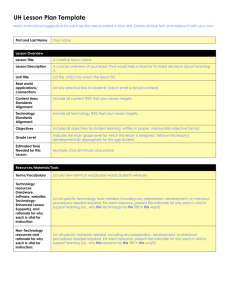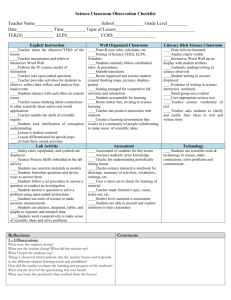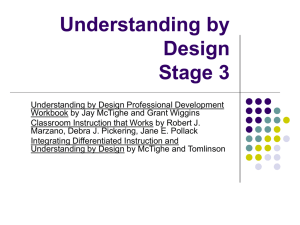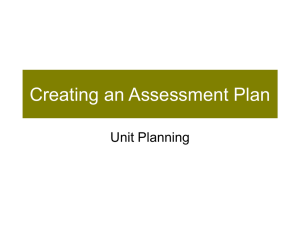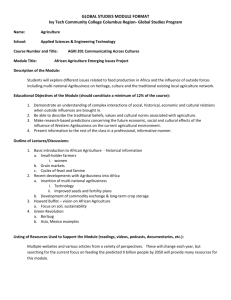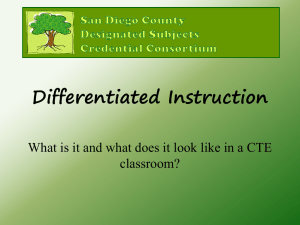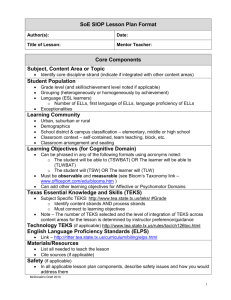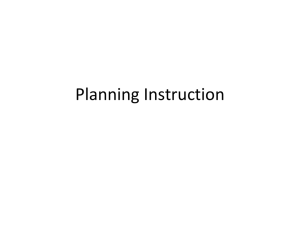Differentiated Instruction in Ag Classroom
advertisement
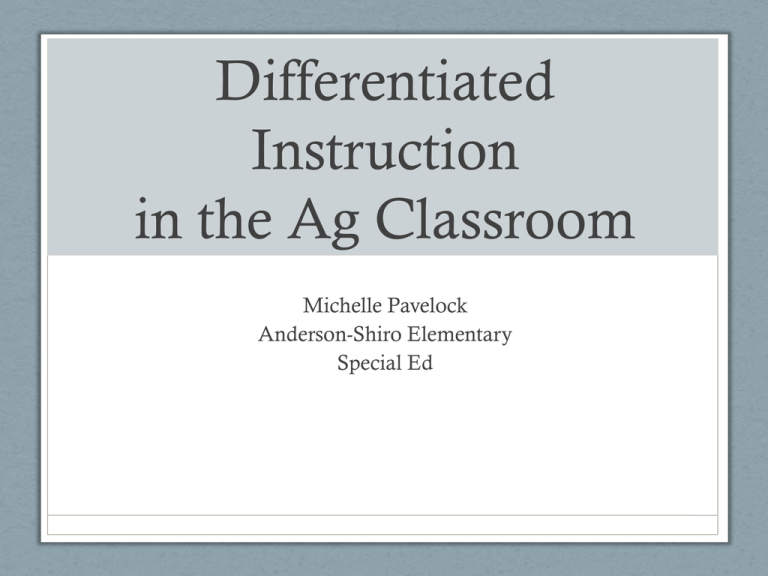
Differentiated Instruction in the Ag Classroom Michelle Pavelock Anderson-Shiro Elementary Special Ed What we need to know… 1. Not all students learn the same way and at the same pace 2. An effective teacher recognizes differences and is able to design lessons to reach all learners at some level 3. It takes time and planning! What is it? Differentiated instruction is a method of instruction designed to recognize students “varying background knowledge, readiness, language, preferences in learning, interests; and to react responsively. Differentiated instruction is a process to approach teaching and learning for students of differing abilities in the same class. The intent of differentiating instruction is to maximize each student’s growth and individual success by meeting each student where he or she is, and assisting in the learning process,” (Hall, 2009). Why does it matter in ag? • Career and tech has been largely ignored in instructional strategy focus because there has been no major test like the TAKS • However, keep this in mind… Food for thought… “It is our learning disabled students who could possibly benefit most from the things agricultural education has to offer. Career and technical education has the potential to give students concrete skills that they can use in the job market and hopefully have an equal opportunity at employment” (Moffitt, 2004). How do we do it? You have to take time to PLAN!!!!!! You have to learn to accommodate!!!!!!!! You have to learn to modify!!!!!!! Accommodations • An accommodation is anything you can do to help ANY student be more successful • Moving them closer to the teacher (preferential seating) • Giving extra time on an assignment • Peer tutoring • Providing a copy of the class notes • Retesting • Allowing for corrections on an assignments • Oral administration of tests Modification • A change in TEKS (or curriculum) • Lowered passing standard • Change in the expectation of mastery • Anything where that student is not held to the same level of expectation as the other students Modification example • TEK: (c) Knowledge and skills. • (1) The student learns the employability characteristics of a successful worker in the modern workplace. The student is expected to: • (A) identify career development and entrepreneurship opportunities in the field of agriculture/agribusiness; • (B) apply competencies related to resources, information, interpersonal skills, and systems of operation in agriculture/agribusiness; • (C) demonstrate knowledge of personal and occupational safety practices in the workplace; • (D) identify employers' expectations, appropriate work habits, and good citizenship skills; and • (E) plan supervised agricultural experience programs. Modified TEK for SpEd • (1) The student learns the employability characteristics of a successful worker in the modern workplace. The student is expected to: • (A) identify career development and entrepreneurship opportunities in the field of agriculture/agribusiness; • (D) identify employers' expectations, appropriate work habits, and good citizenship skills Pointers for a/m • Don’t be such a hard head that you set your students up for failure • Be sensitive to learners’ needs • Not every child is the same. Don’t treat them that way. • Understand that sometimes you have to go the extra mile, but it’s worth it. Types of differentiated instruction • Cooperative learning-most popular; effective if done RIGHT. • Problems can come up with how students are put together (one kid does all the work, one kid won’t work at all, etc.) • Use spinners or popsicle sticks for random groups; take the time ahead to put kids together who are different ability levels; Utilize different kinds of groups!!! Other methods • Questions, cues, and advanced organizers • Using models, building models • Centers-very underused at the secondary level • Set them up in your room and let kids work through them at their own pace • Very effective There is no end to what you can do. It’s whatever you can come up with to reach every child at SOME level. Our activity • In your classroom today, you will be teaching a unit from the FFA manual. This will address your TEKS objectives dealing with the history of agriculture. • Your main focus will be on important dates in the history of the FFA. • In your classroom, you have 2 GT students, 10 regular education students, and 3 special ed. You will be given a copy of their page 4’s. Directions… • Using the provided class information, develop a mini-lesson that meets the needs of all learners in your room • Covers the TEKS objective for the day • Tell me how you would develop an assessment to gauge the learning of each learner in your room
